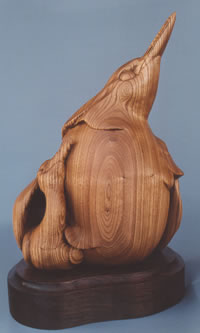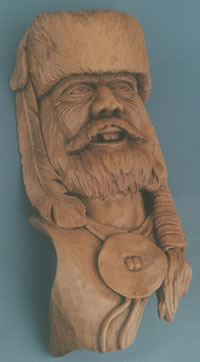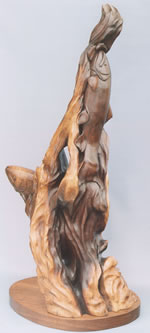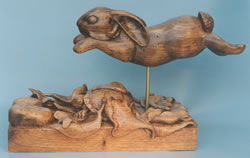|
 ARTIST
OF THE MONTH -
NOVEMBER 2001 ARTIST
OF THE MONTH -
NOVEMBER 2001
Nick Eason - Wildlife Sculptor
by Carol Nabrotzky Wells
Nick Eason, permanent resident of
Moab since 1995, has won many awards and much recognition
for his wildlife wood sculptures. His passion for carving
wood began largely by accident when he found a book on carving
and whittling in his local library, over thirty years ago.
Armed with a pocket knife and some wood found in the alley,
Eason carved out his first piece, a simple wooden duck. The
comparison of the simplicity of his first duck with to the
complexity of the barn owl that I saw in-progress in his studio
express the time, work, and concentration, which Eason has
focussed into his passion for carving. Skill and dedication
are a large part of what distinguishes Eason¹s work in
juried shows today.
Eason sculpts his wooden figures in a sleek and lustrous fashion,
paying attention to the details, but removing some of the
hard and rough textures from the final product. This blend
of fidelity to the proportion and accuracy with the simplification
of detail characterizes his style, ‘simplified realism’.
Eason favors birds and foul and small mammals for his subject
matter in his wildlife carvings. But, he has also carved large
aquatic mammals, like a variety of whales, and caricatures
of humans, trolls, and humanlike
figures. His sculptures are primarily done in the native hard
woods, such as sycamore, black walnut, mahogany, and cherry.
 The
first element of Eason’s creative process is to have
the creative spark ignited by a gesture, movement, or pose
that he witnesses in the natural world. Then with the help
of nature photographs and research about the specific animal,
Eason creates a clay sketch of the animal to work out the
composition and design elements. When a suitable piece of
wood has been found to accommodate the sculpture, Eason begins
a long process of carving the wood with various tools and
chisels. A large piece, like “Heading Home” could
take at least 300 hours or more just to do the carving and
finishing of the sculpture. The
first element of Eason’s creative process is to have
the creative spark ignited by a gesture, movement, or pose
that he witnesses in the natural world. Then with the help
of nature photographs and research about the specific animal,
Eason creates a clay sketch of the animal to work out the
composition and design elements. When a suitable piece of
wood has been found to accommodate the sculpture, Eason begins
a long process of carving the wood with various tools and
chisels. A large piece, like “Heading Home” could
take at least 300 hours or more just to do the carving and
finishing of the sculpture.
“Heading Home” exhibits two trout swimming up stream
struggling against the fluid motion of the carved water. One
fish¹s head pops out against the rushof the current.
Smooth deep cuts and wavy lines express the motion of the
water. Eason creates a sense of lightness and flow by hollowing
out particular areas of the sculptural base. He maintains
the structural integrity of the piece, while exaggerating
the movements visually as the dynamism stretches into three
dimensions. This ability to invent and sculpt in an asymmetrical
and dynamic fashion is a technically advanced ability. Unlike
his symmetrical, even, and simple first sculptures from thirty
years ago, Eason¹s current work expresses the eye and
experience of a master sculptor.
Much of the movement expressed in Eason¹s sculpture is
similar to the movement captured by the famous French sculptor
Auguste Rodin (1840-1917) in his bronze and marble sculptures.
Rodin was famous for the way he expressed motion in a line
or gesture, which suggested that the sculpture was eternally
in motion rather than being an inert and cold representation
of the subject. Overcoming the structural elements in creating
a bronze with movement is seemingly easy when compared with
the marble or wood, as the metal supports a broader range
of weight. A wood or marble piece, which is created by subtraction—
removing the layers of material— must be supported by
the actual block it is carved out of. So there are certain
physical limitations that a subtractive sculptor must account
for: how to orient the weight relationships in the sculpture,
how to express movement, three-dimensionality, and flow without
allowing the sculpture to become blocky or have delicate appendages
of the sculpture which are in danger of breaking.
 Eason
did not say it to me directly, but there is a profound love
and sensitivity to nature in his sculptures. The subtle and
delicate gestures, created by the slight twist of the head
in “Heads Up”, reveal Eason’s careful attention
to the beauty, complexity and mystery discovered in his attentive
observation. Eason worked for 32 years in the National Park
Service moving all over the country and living at a various
parks, including living in Moab from 1982-88, at which he
encountered a wide range of climates, animals, and habitats.
Eason does have a collection of images and articles that provide
the research for a subsequent sculpture. The life and soul-fullness
evident in his recent sculptures, however, are founded two
characteristics of his work: perfected technique in rendering
the subject and an awareness and passion for the subject.
Take “Forbidden Fruit”, for example, carved out
of black walnut: the intensity of the head angle and stare
of the bird, and the way the tail lifts directly vertical.
These are feats expressive genius, as far as being able to
balance the sculpture, create dynamism and intrigue, and maintain
true to the proportions and habitat of the specific animal.
“Forbidden Fruit” recently won first place, ‘best
in show’, in professional sculpture Glenwood Springs,
2001 Fall Arts Festival. The smooth lines compliment the complexity
of the pose and gesture of the base. Eason
did not say it to me directly, but there is a profound love
and sensitivity to nature in his sculptures. The subtle and
delicate gestures, created by the slight twist of the head
in “Heads Up”, reveal Eason’s careful attention
to the beauty, complexity and mystery discovered in his attentive
observation. Eason worked for 32 years in the National Park
Service moving all over the country and living at a various
parks, including living in Moab from 1982-88, at which he
encountered a wide range of climates, animals, and habitats.
Eason does have a collection of images and articles that provide
the research for a subsequent sculpture. The life and soul-fullness
evident in his recent sculptures, however, are founded two
characteristics of his work: perfected technique in rendering
the subject and an awareness and passion for the subject.
Take “Forbidden Fruit”, for example, carved out
of black walnut: the intensity of the head angle and stare
of the bird, and the way the tail lifts directly vertical.
These are feats expressive genius, as far as being able to
balance the sculpture, create dynamism and intrigue, and maintain
true to the proportions and habitat of the specific animal.
“Forbidden Fruit” recently won first place, ‘best
in show’, in professional sculpture Glenwood Springs,
2001 Fall Arts Festival. The smooth lines compliment the complexity
of the pose and gesture of the base.
Eason cited an Oklahoma sculptor by the name of Willard Stone
(1916-1985) for the inspiration of this style of wildlife
sculpture. Stone, a carver of Cherokee decent, Eason created
wildlife wood sculpture in a similar form of simplified realism.
The high polish is very sensual and invites the viewer to
reach out and fondle Eason’s work. Which is fortunate
in the case ‘Netsuke’ a newer exploration for Eason.
Netsuke derives from a Japanese tradition of carving small
toggles out of hard woods that were originally used to fasten
a purse or a tobacco pouch to a kimono sash to prevent these
items from being lost. The netsuke are a highly collectible
form of stylized small sculpture. In the tradition of netsuke
the figures are rounded off without hard edges, which makes
it gentle to the touch and easily held in the palm of the
hand. The subjects of the netsuke are generally animals, nature,
and faces (grotesque and humorous). The netsuke are generally
carved in harder woods, like boxwood, fruit and topical hardwoods,
than that of his larger sculptures. At the Overlook Gallery
in Moab, Eason has a range of ‘netsuke’ and some
larger sculptures. In December, some of his work will be featured
as part of a larger group show.

An instructor of Eason’s once warned him, if you are
serious about a career in sculpture do not do wood, and do
not do wildlife. I am sure glad he did not listen to this
advice. It seems, rather, that he followed the wisdom of Joseph
Campbell, “follow your bliss,” which would account
for the sensitivity, passion, drama, and sensuality of his
wildlife wood sculptures.
|


 Eason
did not say it to me directly, but there is a profound love
and sensitivity to nature in his sculptures. The subtle and
delicate gestures, created by the slight twist of the head
in “Heads Up”, reveal Eason’s careful attention
to the beauty, complexity and mystery discovered in his attentive
observation. Eason worked for 32 years in the National Park
Service moving all over the country and living at a various
parks, including living in Moab from 1982-88, at which he
encountered a wide range of climates, animals, and habitats.
Eason does have a collection of images and articles that provide
the research for a subsequent sculpture. The life and soul-fullness
evident in his recent sculptures, however, are founded two
characteristics of his work: perfected technique in rendering
the subject and an awareness and passion for the subject.
Take “Forbidden Fruit”, for example, carved out
of black walnut: the intensity of the head angle and stare
of the bird, and the way the tail lifts directly vertical.
These are feats expressive genius, as far as being able to
balance the sculpture, create dynamism and intrigue, and maintain
true to the proportions and habitat of the specific animal.
“Forbidden Fruit” recently won first place, ‘best
in show’, in professional sculpture Glenwood Springs,
2001 Fall Arts Festival. The smooth lines compliment the complexity
of the pose and gesture of the base.
Eason
did not say it to me directly, but there is a profound love
and sensitivity to nature in his sculptures. The subtle and
delicate gestures, created by the slight twist of the head
in “Heads Up”, reveal Eason’s careful attention
to the beauty, complexity and mystery discovered in his attentive
observation. Eason worked for 32 years in the National Park
Service moving all over the country and living at a various
parks, including living in Moab from 1982-88, at which he
encountered a wide range of climates, animals, and habitats.
Eason does have a collection of images and articles that provide
the research for a subsequent sculpture. The life and soul-fullness
evident in his recent sculptures, however, are founded two
characteristics of his work: perfected technique in rendering
the subject and an awareness and passion for the subject.
Take “Forbidden Fruit”, for example, carved out
of black walnut: the intensity of the head angle and stare
of the bird, and the way the tail lifts directly vertical.
These are feats expressive genius, as far as being able to
balance the sculpture, create dynamism and intrigue, and maintain
true to the proportions and habitat of the specific animal.
“Forbidden Fruit” recently won first place, ‘best
in show’, in professional sculpture Glenwood Springs,
2001 Fall Arts Festival. The smooth lines compliment the complexity
of the pose and gesture of the base.